Podcast: Play in new window | Download
Subscribe: Apple Podcasts | RSS
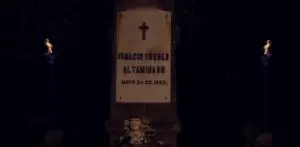 The date is May 24th 1882. A big storm was about to hit the city of Guadalajara, the capital and center of commerce of Mexico’s state of Jalisco. A young couple was putting their son to bed, a boy who was not even 10 years old. His name was Ignacio Torres Altimirano. His parents and grandparents lovingly called the young boy “Nachito.” As Nachito was afraid of the dark, he always had to sleep with two lit torches outside his bedroom window and slept with the windows open. On this night in May when the storm hit Guadalajara, the torches blew out. In the morning the next day Nachito’s mother entered his room and could immediately tell something was very wrong as the room was extremely cold. She ran to her son’s bed to find Nachito motionless and as cold as the room. It was later determined that Nachito had died of a heart attack that night because of his intense, almost pathological, fear of the dark. Rumors began to spread that the young boy’s heart had exploded inside his chest and Nachito’s horrible death was the result of a curse or was the work of demons. Nachito was quickly interred at the nearby cemetery – called by locals, El Panteón de Belén – and the strangeness that began with his death did not end quickly. The next morning, the boy’s coffin was found disinterred and lying peacefully on the ground next to the hole that was Nachito’s grave. The parents and the locals alike were alarmed and the cemetery caretaker reburied
The date is May 24th 1882. A big storm was about to hit the city of Guadalajara, the capital and center of commerce of Mexico’s state of Jalisco. A young couple was putting their son to bed, a boy who was not even 10 years old. His name was Ignacio Torres Altimirano. His parents and grandparents lovingly called the young boy “Nachito.” As Nachito was afraid of the dark, he always had to sleep with two lit torches outside his bedroom window and slept with the windows open. On this night in May when the storm hit Guadalajara, the torches blew out. In the morning the next day Nachito’s mother entered his room and could immediately tell something was very wrong as the room was extremely cold. She ran to her son’s bed to find Nachito motionless and as cold as the room. It was later determined that Nachito had died of a heart attack that night because of his intense, almost pathological, fear of the dark. Rumors began to spread that the young boy’s heart had exploded inside his chest and Nachito’s horrible death was the result of a curse or was the work of demons. Nachito was quickly interred at the nearby cemetery – called by locals, El Panteón de Belén – and the strangeness that began with his death did not end quickly. The next morning, the boy’s coffin was found disinterred and lying peacefully on the ground next to the hole that was Nachito’s grave. The parents and the locals alike were alarmed and the cemetery caretaker reburied 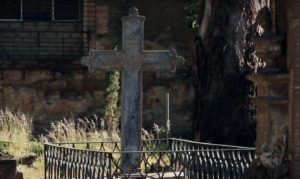 the boy’s coffin. The next morning, the same thing happened, and it happened again for 9 consecutive days. Nachito’s parents concluded that because the boy was so afraid of the dark, he did not want to be kept in the ground away from the light. The solution was to create a stone coffin to stand on 4 short pillars above the ground, so Nachito’s tomb could always see sunlight. Since the time of Nachito’s death many people visiting the cemetery have claimed to have either seen or heard a young boy matching Nachito’s description, or have seen mysterious balloons floating evenly about 3 to 4 feet over the cemetery as if being carried by a small child. Strangely, Nachito’s tomb draws the curious from all parts of Mexico, some of whom leave him a toy and ask him for a favor. On Children’s Day – April 30th – and Christmas Day especially, the area surrounding Nachito’s final resting place can become covered in small toys and plush animals. The caretakers of the cemetery always donate the offerings to local hospitals and the items end up in the hands of terminally ill children. From beyond the grave little Nachito continues to have an impact on the living world from his permanent home in this cemetery.
the boy’s coffin. The next morning, the same thing happened, and it happened again for 9 consecutive days. Nachito’s parents concluded that because the boy was so afraid of the dark, he did not want to be kept in the ground away from the light. The solution was to create a stone coffin to stand on 4 short pillars above the ground, so Nachito’s tomb could always see sunlight. Since the time of Nachito’s death many people visiting the cemetery have claimed to have either seen or heard a young boy matching Nachito’s description, or have seen mysterious balloons floating evenly about 3 to 4 feet over the cemetery as if being carried by a small child. Strangely, Nachito’s tomb draws the curious from all parts of Mexico, some of whom leave him a toy and ask him for a favor. On Children’s Day – April 30th – and Christmas Day especially, the area surrounding Nachito’s final resting place can become covered in small toys and plush animals. The caretakers of the cemetery always donate the offerings to local hospitals and the items end up in the hands of terminally ill children. From beyond the grave little Nachito continues to have an impact on the living world from his permanent home in this cemetery.
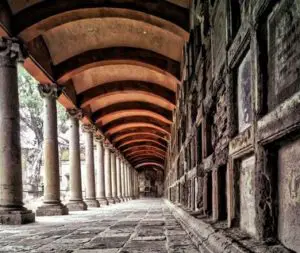 The Santa Paula Cemetery – also known locally as the Panteón de Belén – is located north of the Metropolitan Cathedral of Guadalajara in the heart of Mexico’s third largest city. The cemetery was built in 1848, and was located next to the old civic hospital in a former orchard called San Miguel Belén from where it gets is locally-known name. The name Cementerio de Santa Paula, or in English, the Saint Paula Cemetery, comes from the fact that there is a chapel dedicated to the saint on the cemetery grounds. The cemetery was designed by the famous Mexican architect, Manuel Gómez Ibarra, who, 30 years earlier, redesigned the spires of the Guadalajara cathedral which were destroyed in an earthquake. Santa Paula was initially divided into two sections: one for the wealthy citizens of Guadalajara and one for the not-so wealthy. The cemetery design is mostly neo-classical with great influence from French architecture, as that was the style in mid-19th Century Mexico. As the cemetery was open for almost 50 years there are other architectural influences present, including neo-Gothic and Baroque. In the center of the cemetery is a small chapel that is topped with a high, pointy roof that shows Egyptian influence. This building was supposed to serve as a mausoleum to house the “Illustrious Citizens of Guadalajara” but the “Illustrious” got their own separate monument closer to
The Santa Paula Cemetery – also known locally as the Panteón de Belén – is located north of the Metropolitan Cathedral of Guadalajara in the heart of Mexico’s third largest city. The cemetery was built in 1848, and was located next to the old civic hospital in a former orchard called San Miguel Belén from where it gets is locally-known name. The name Cementerio de Santa Paula, or in English, the Saint Paula Cemetery, comes from the fact that there is a chapel dedicated to the saint on the cemetery grounds. The cemetery was designed by the famous Mexican architect, Manuel Gómez Ibarra, who, 30 years earlier, redesigned the spires of the Guadalajara cathedral which were destroyed in an earthquake. Santa Paula was initially divided into two sections: one for the wealthy citizens of Guadalajara and one for the not-so wealthy. The cemetery design is mostly neo-classical with great influence from French architecture, as that was the style in mid-19th Century Mexico. As the cemetery was open for almost 50 years there are other architectural influences present, including neo-Gothic and Baroque. In the center of the cemetery is a small chapel that is topped with a high, pointy roof that shows Egyptian influence. This building was supposed to serve as a mausoleum to house the “Illustrious Citizens of Guadalajara” but the “Illustrious” got their own separate monument closer to 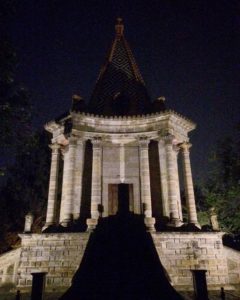 the cathedral. Santa Paula’s largest building is the main mausoleum which contains 900 niches and is fringed by a colonnade of pink cantera-stone columns with classical ionic finishes. The main cemetery is full of tombstones and monuments reflecting an eclectic style. Large trees throughout provide ample shade. The Cemetery of Santa Paula draws many thousands of tourists annually who not only come to view the architectural beauty or to enjoy the adjacent museum, but come for the nighttime ghost tours and are fascinated by Santa Paula’s many legends. As far as places in Mexico with alleged paranormal activity go, this cemetery may be the one location in the whole country with more ghostly shenanigans than any other, and a bulk of this activity is based on the many legends that emanate from here. Among these legends we find stories involving a pirate, a sick boy who lost his faith and a vampire. These are only a few.
the cathedral. Santa Paula’s largest building is the main mausoleum which contains 900 niches and is fringed by a colonnade of pink cantera-stone columns with classical ionic finishes. The main cemetery is full of tombstones and monuments reflecting an eclectic style. Large trees throughout provide ample shade. The Cemetery of Santa Paula draws many thousands of tourists annually who not only come to view the architectural beauty or to enjoy the adjacent museum, but come for the nighttime ghost tours and are fascinated by Santa Paula’s many legends. As far as places in Mexico with alleged paranormal activity go, this cemetery may be the one location in the whole country with more ghostly shenanigans than any other, and a bulk of this activity is based on the many legends that emanate from here. Among these legends we find stories involving a pirate, a sick boy who lost his faith and a vampire. These are only a few.
The legend of the pirate goes something like this: A swashbuckling man once sailed the Pacific during his youth and attacked many ships laden with the riches of the Orient. As a middle-aged man, the pirate decided to settle and make a life for himself in Guadalajara. He had only one son, but the son did not know of his father’s former life as a buccaneer on the high seas. The man had stashed somewhere in the Guadalajara area a massive treasure comprised mostly of gold and precious stones. A few months after hiding his pirate treasure, the man died and was buried in the Santa Paula 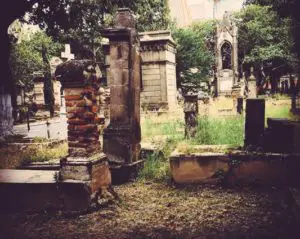 Cemetery. According to the legend, if a devout person visits the pirate’s grave at midnight and prays the rosary for the man’s tormented soul, the ghost of the pirate will reveal the exact location of the treasure. As people have been trying this for years, it is said that the ghost has not yet found the proper devout person.
Cemetery. According to the legend, if a devout person visits the pirate’s grave at midnight and prays the rosary for the man’s tormented soul, the ghost of the pirate will reveal the exact location of the treasure. As people have been trying this for years, it is said that the ghost has not yet found the proper devout person.
Another Santa Paula legend involving a child is connected to the former hospital next door. A young boy named Santiago was suffering from a terminal stomach ailment. In some stories it is an aggressive type of cancer. During one of her visits, Santiago’s mother brought the boy one of his favorite saint statues from home, to help give her son comfort through his illness. While he was sleeping, the mother placed the small statue in the boy’s hands. When Santiago awoke, he threw the statue up against the wall, cursing God for giving him such a terrible disease. He yelled to anyone who would hear his wish that God himself would contract the horrible illness that he was suffering from. Santiago ended his rant by saying smugly, “If God gets this disease, let’s see who will cure Him.” That night, the boy’s pain was more intense than ever and he wandered outside the hospital and into the cemetery. The next 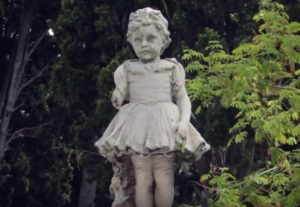 morning the boy’s body was found hanging from a tree, the hospital bed sheets used as a noose. Sometimes at night people claim to see the young Santiago hanging from a tree inside the Santa Paula Cemetery. The story is told to children so that they will not lose their faith in God.
morning the boy’s body was found hanging from a tree, the hospital bed sheets used as a noose. Sometimes at night people claim to see the young Santiago hanging from a tree inside the Santa Paula Cemetery. The story is told to children so that they will not lose their faith in God.
One of the most interesting stories connected with this cemetery has to do with a vampire. In the mid-1800s, so the story goes, scores of small animals were found throughout Guadalajara dead and with all their blood gone. After months of this strange animal exsanguination, the same phenomenon started to happen to human infants. The alarmed citizenry then formed a vigilante group to hunt down the supposed vampire who was responsible for this. The mob rounded up a few suspects and singled out the palest and most vampiric-looking man of the group. As is customary according to the rules in vampire lore, they drove a stake through the man’s heart to kill him. The group then took the man’s body to Santa Paula, placing it under a large stone slab. 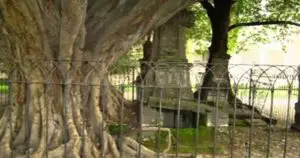 The townsfolk rejoiced when the vampire attacks ceased, thus proving that they had killed the right man. A tree started to grow over the slab covering the vampire’s grave and now the tree is quite large. It is said that if you break a branch off of this tree, it will spurt blood, and even the leaves of the tree will leave a strange red residue in your hands if you handle them for an extended period. The tree is now rather large with a huge root system that grabs the slab like the tentacles of an octopus. It is said that when the tree’s root system eventually breaks the slab or causes a gap between the slab and the rest of the tomb, the vampire will escape and seek revenge on the modern citizens of a cosmopolitan Guadalajara.
The townsfolk rejoiced when the vampire attacks ceased, thus proving that they had killed the right man. A tree started to grow over the slab covering the vampire’s grave and now the tree is quite large. It is said that if you break a branch off of this tree, it will spurt blood, and even the leaves of the tree will leave a strange red residue in your hands if you handle them for an extended period. The tree is now rather large with a huge root system that grabs the slab like the tentacles of an octopus. It is said that when the tree’s root system eventually breaks the slab or causes a gap between the slab and the rest of the tomb, the vampire will escape and seek revenge on the modern citizens of a cosmopolitan Guadalajara.
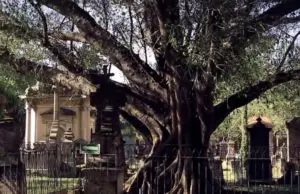 While the dozens of legends abound and tourists flock to the Santa Paula Cemetery for the thrill of the nighttime ghost tours, the graveyard has attracted the attention of many serious paranormal researchers. Of special interest is Nachito, as many caretakers and passersby have had unexplained experiences connected with the boy or his grave. In 2015 an investigative ghost hunting team went to the Santa Paula Cemetery armed with cameras and an EVP recorder. EVP stands for “Electronic Voice Phenomenon” and the EVP recorder supposedly can record the sounds made by ghosts and other non-corporeal beings. In this instance, the EVP recorder was set up near Nachito’s grave and along with the cameras was left running all night during one of the nights of the investigation. Later, the recording was dissected and analyzed and the researchers discovered what appeared to be the voice of a little boy once all ambient noises were taken away. The voice said, “Oye, encontraste mi tumba, me das un chocolatito.” In English, this translates to, “Hey, you found my grave, now give me a little piece of chocolate.” Whether or not this was little Nachito making demands from the Great Beyond or someone playing a trick may never be known. The one thing we know for certain is that the Santa Paula Cemetery will continue to generate the fascinating stuff of legends for many years to come.
While the dozens of legends abound and tourists flock to the Santa Paula Cemetery for the thrill of the nighttime ghost tours, the graveyard has attracted the attention of many serious paranormal researchers. Of special interest is Nachito, as many caretakers and passersby have had unexplained experiences connected with the boy or his grave. In 2015 an investigative ghost hunting team went to the Santa Paula Cemetery armed with cameras and an EVP recorder. EVP stands for “Electronic Voice Phenomenon” and the EVP recorder supposedly can record the sounds made by ghosts and other non-corporeal beings. In this instance, the EVP recorder was set up near Nachito’s grave and along with the cameras was left running all night during one of the nights of the investigation. Later, the recording was dissected and analyzed and the researchers discovered what appeared to be the voice of a little boy once all ambient noises were taken away. The voice said, “Oye, encontraste mi tumba, me das un chocolatito.” In English, this translates to, “Hey, you found my grave, now give me a little piece of chocolate.” Whether or not this was little Nachito making demands from the Great Beyond or someone playing a trick may never be known. The one thing we know for certain is that the Santa Paula Cemetery will continue to generate the fascinating stuff of legends for many years to come.
REFERENCES
Brochures from the Museo de Panteón de Belén (in Spanish)

4 thoughts on “The Legends of the Santa Paula Cemetery”
What a great show!!!! I was amazed to hear this marvelous story. I can not believe all of this happens right here in the city where I live. Although eventually I ve heard about Panteon de Belen I havent taken the time to actually go and tour the cementery. I have met some people who have actually taken the tour aroun the cementery and said it indeed is a great experience.
Now that I have heard this story form Mr: Bitto I will definetly take the time and see the cementery one of this days. Perhapes Semana SAnta will be the perfect time for me to go and see this cementery. I am so thrilled to see EL PANTEON DE BELEN as one episode of Mexivo unesplained! Thanks Mr. Bitto for enlighting the world with your fine episodes.
Gracias! Thank you for your support. It is very much appreciated.
so ive been harrassed online over a ghost story? great thanks that must be the voicemail i saved very christian
I’m sorry, I don’t understand what you are saying. Can you please clarify? Thanks.